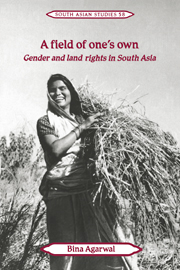Book contents
- Frontmatter
- Contents
- List of illustrations
- List of tables
- Preface
- Map 1.1 South Asia: provincial/state divisions
- 1 Land rights for women: making the case
- 2 Conceptualizing gender relations
- 3 Customary rights and associated practices
- 4 Erosion and disinheritance: traditionally matrilineal and bilateral communities
- 5 Contemporary laws: contestation and content
- 6 Whose share? Who claims? The gap between law and practice
- 7 Whose land? Who commands? The gap between ownership and control
- 8 Tracing cross-regional diversities
- 9 Struggles over resources, struggles over meanings
- 10 The long march ahead
- Definitions
- Glossary
- References
- Index
- Cambridge South Asian Studies
2 - Conceptualizing gender relations
Published online by Cambridge University Press: 14 January 2010
- Frontmatter
- Contents
- List of illustrations
- List of tables
- Preface
- Map 1.1 South Asia: provincial/state divisions
- 1 Land rights for women: making the case
- 2 Conceptualizing gender relations
- 3 Customary rights and associated practices
- 4 Erosion and disinheritance: traditionally matrilineal and bilateral communities
- 5 Contemporary laws: contestation and content
- 6 Whose share? Who claims? The gap between law and practice
- 7 Whose land? Who commands? The gap between ownership and control
- 8 Tracing cross-regional diversities
- 9 Struggles over resources, struggles over meanings
- 10 The long march ahead
- Definitions
- Glossary
- References
- Index
- Cambridge South Asian Studies
Summary
Please go and ask the sarkar [government] why when it distributes land we don't get a title? Are we not peasants? If my husband throws me out, what is my security?
Economists of both persuasions [neoclassical and Marxist] tend to treat the household as though it were an almost wholly cooperative, altruistic unit. Today, however, they are confronted by certain ‘anomalies’ – empirical evidence of economic conflict and inequality within the household.
(Folbre 1986: 245)Gender relations are neither uniform across societies nor historically static. A vast array of studies of different cultures, regions, and communities bears this out, as does the material on South Asia in this book. However, these call for a conceptual framework that would help us characterize gender relations, explain how they are maintained, and identify the processes by which they might change over time. This chapter is an attempt in that direction.
The term gender relations as used here refers to the relations of power between women and men which are revealed in a range of practices, ideas, and representations, including the division of labour, roles, and resources between women and men, and the ascribing to them of different abilities, attitudes, desires, personality traits, behavioural patterns, and so on. Gender relations are both constituted by and help constitute these practices and ideologies in interaction with other structures of social hierarchy such as class, caste, and race. They may be seen as largely socially constructed (rather than biologically determined), and as variable over time and place.
- Type
- Chapter
- Information
- A Field of One's OwnGender and Land Rights in South Asia, pp. 51 - 81Publisher: Cambridge University PressPrint publication year: 1995

